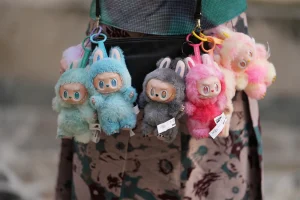6-7. A word that creeps into casual conversations, a word that turns into a cause for boisterous laughter, a word that is even referenced by teachers on occasion. This nonsensical meme originated from a lyric from the song “Doot Doot (6 7)” by the artist Skrilla. Later, 6-7 was referenced in many basketball edits of professional players (such as LaMelo Ball) until it finally went viral on YouTube Shorts and TikTok when the dubbed “6-7 kid” said the phrase at a basketball game. While 6-7 is a recent brainrot culture phenomenon, there are other examples of similar influence.

The term brainrot was first coined in 1854 in Walden, written by Henry David Thoreau, where he described a phenomenon which he imagined as the overall decline of intelligence and the ability to think beyond what is surface level. In the 2000s, the term was used more commonly with the emergence of lower quality media featuring crude humor and similar absurdities. Today, the term is described as low quality digital media and the deterioration of intelligence from long term consumption.
A noteworthy aspect of brainrot culture is Italian brainrot. Italian brainrot is a viral series of AI generated memes emerging in early 2025, known for surrealist and absurd images of creatures and a nonsensical narrative. This content can be overstimulating for many and has even been suggested to be potentially affect cognitive function for developing children and teens. Italian brainrot is referred to as overwhelmingly low quality and the potential death of creativity for the sake of notoriety. Similarly, many YouTube channels, coined content farms, use Italian brainrot characters as a way to farm views and profit. Although digital forms of brainrot are common, there is also an aspect of materialism to the concept of brainrot.
While digital media is one kind of brainrot, the same mindset shows up in material obsessions like Labubus. Marketed through exclusive and manipulative campaigns, these odd collectibles have become symbols of consumerism and empty fascination. The craze feeds on the human urge for pride and status, turning ownership into a short-lived badge of worth. In the end, the appeal of Labubus lies in the chase—a quick hit of satisfaction that fades just as fast as the next trend arrives.

As for how brainrot will affect future generations, there are many uncertainties. While Gen Alpha and Gen Beta will have greater reliance on technology, there is no telling how greater access to that resource will become an opportunity or act as a risk to a developing society. Access to brainrot content could lead to unfortunate cognitive changes, such as shorter attention spans, and threaten our ability to learn and take in information. Additionally, reliance on social media and meaningless content for entertainment could desensitize us emotionally and contribute to the mental health crisis of teens globally. Whether brainrot culture develops into an inescapable phenomenon or fad, the scale of influence is evident in this age of technological reliance.


